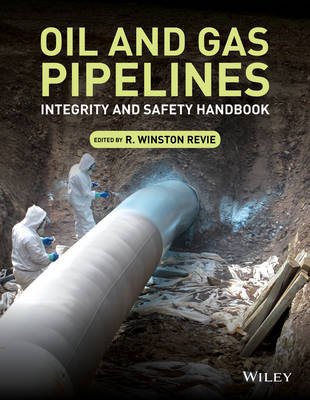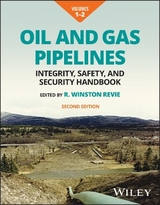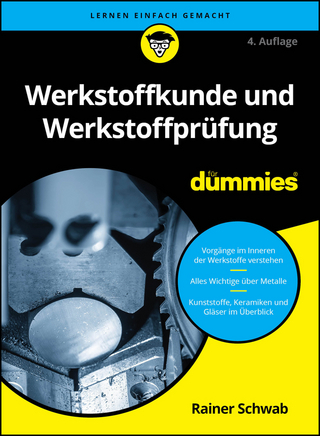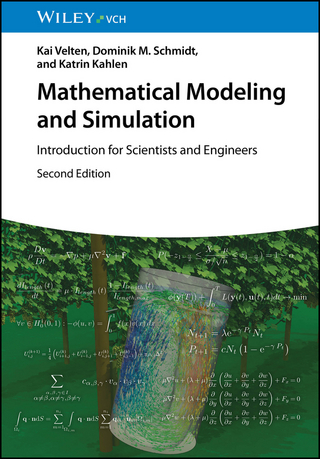
Oil and Gas Pipelines
John Wiley & Sons Inc (Verlag)
978-1-118-21671-2 (ISBN)
A comprehensive and detailed reference guide on the integrity and safety of oil and gas pipelines, both onshore and offshore
Covers a wide variety of topics, including design, pipe manufacture, pipeline welding, human factors, residual stresses, mechanical damage, fracture and corrosion, protection, inspection and monitoring, pipeline cleaning, direct assessment, repair, risk management, and abandonment
Links modern and vintage practices to help integrity engineers better understand their system and apply up-to-date technology to older infrastructure
Includes case histories with examples of solutions to complex problems related to pipeline integrity
Includes chapters on stress-based and strain-based design, the latter being a novel type of design that has only recently been investigated by designer firms and regulators
Provides information to help those who are responsible to establish procedures for ensuring pipeline integrity and safety
R. Winston Revie retired from the CANMET Materials Technology Laboratory, Ottawa, Canada, in 2011, after 33 years as a scientist, project leader, and program manager for pipeline technology. He is a Past President of the Metallurgical Society of the Canadian Institute of Mining, Metallurgy and Petroleum, a Past President of the NACE Foundation of Canada, and a Past Director of NACE International. He received the Distinguished Technical Achievement Award of NACE International in 2004 and has received Fellow honors from CIM (1999), NACE International (1999), ASM International (2003), and The Electrochemical Society (2012) among other awards for his work. He has authored or co-authored more than 100 reference papers and technical reports and was the editor of Uhlig's Corrosion Handbook, 2nd and 3rd editions (Wiley, 2000 and 2011), and he co-authored the 3rd and 4th editions of Corrosion and Corrosion Control (Wiley, 1985 and 2008).
Preface xxxi
Contributors xxxiii
Part I Design
1 Pipeline Integrity Management Systems (PIMS) 3
Ray Goodfellow and Katherine Jonsson
1.1 Introduction 3
1.2 Lessons Learned and the Evolution of Pipeline Integrity 4
1.3 What Is a PIMS? 4
1.4 Regulatory Requirements 5
1.5 Core Structure and PIMS Elements 6
1.6 PIMS Function Map 8
1.7 Plan: Strategic and Operational 8
1.8 Do: Execute 9
1.9 Check: Assurance and Verification 10
1.10 Act: Management Review 10
1.11 Culture 11
1.12 Summary 11
References 11
2 SCADA: Supervisory Control and Data Acquisition 13
Michael VanderZee, Doug Fisher, Gail Powley, and Rumi Mohammad
2.1 Introduction 13
2.2 SCADA Computer Servers 14
2.3 SCADA Computer Workstations 14
References 26
3 Material Selection for Fracture Control 27
William Tyson
3.1 Overview of Fracture Control 27
3.2 Toughness Requirements: Initiation 28
References 34
4 Strain-Based Design of Pipelines 37
Nader Yoosef-Ghodsi
4.1 Introduction and Basic Concepts 37
4.1.1 Overview of Strain-Based Design 37
4.5 Summary 46
References 46
5 Stress-Based Design of Pipelines 49
Mavis Sika Okyere
5.1 Introduction 49
5.2 Design Pressure 49
5.13 Summary 64
References 65
6 Spiral Welded Pipes for Shallow Offshore Applications 67
Ayman Eltaher
6.1 Introduction 67
6.2 Limitations of the Technology Feasibility 68
6.3 Challenges of Offshore Applications 68
6.3.1 Design Challenges 68
6.3.2 Stress Analysis Challenges 68
6.3.3 Materials and Manufacturing Challenges 69
6.4 Typical Pipe Properties 70
6.5 Technology Qualification 70
6.6 Additional Resources 71
6.7 Summary 71
References 71
7 Residual Stress in Pipelines 73
Paul Prevéy and Douglas Hornbach
7.1 Introduction 73
7.1.1 The Nature of Residual Stresses 73
7.1.2 Sources of Residual Stresses 74
7.2 The Influence of Residual Stresses on Performance 76
7.2.1 Fatigue 77
7.2.2 Stress Corrosion Cracking 78
References 96
8 Pipeline/Soil Interaction Modeling in Support of Pipeline Engineering Design and Integrity 99
Shawn Kenny and Paul Jukes
8.1 Introduction 99
8.2 Site Characterization and Geotechnical Engineering in Relation to Pipeline System Response Analysis 101
8.2.1 Overview 101
8.2.2 Pipeline Routing 102
Acknowledgments 130
References 130
9 Human Factors 143
Lorna Harron
9.1 Introduction 143
9.2 What Is “Human Factors”? 143
9.3 Life Cycle Approach to Human Factors 143
9.9 Summary 154
References 155
Bibliography 155
Part II Manufacture, Fabrication, and Construction
10 Microstructure and Texture Development in Pipeline Steels 159
Roumen H. Petrov, John J. Jonas, Leo A.I. Kestens, and J. Malcolm Gray
10.1 Introduction 159
10.2 Short History of Pipeline Steel Development 160
10.5 Summary 182
Acknowledgments 183
References 183
11 Pipe Manufacture—Introduction 187
Gerhard Knauf and Axel Kulgemeyer
11.1 Pipe Manufacturing Background 187
11.2 Current Trends in Line Pipe Manufacturing 187
References 188
12 Pipe Manufacture—Longitudinal Submerged Arc Welded Large Diameter Pipe 189
Christoph Kalwa
12.1 Introduction 189
12.2 Manufacturing Process 189
12.3 Quality Control Procedures 191
12.4 Range of Grades and Dimensions 192
12.5 Typical Fields of Application 192
13 Pipe Manufacture—Spiral Pipe 195
Franz Martin Knoop
13.1 Manufacturing Process 195
13.2 Quality Control Procedures 198
13.3 Range of Grades and Dimensions 198
13.4 Typical Fields of Applicability 200
References 201
14 Pipe Manufacture—ERW Pipe 203
Holger Brauer and Hendrik Löbbe
14.1 Introduction 203
14.2 Manufacturing Process 203
14.3 Quality Control Procedures 204
14.3.1 Welding Line 205
14.3.2 Finishing Line 206
14.3.3 Destructive Material Testing 208
14.4 Range of Grades and Dimensions 208
14.5 Typical Fields of Applicability 208
References 209
15 Pipe Manufacture—Seamless Tube and Pipe 211
Rolf Kümmerling and Klaus Kraemer
15.1 The Rolling Process 211
15.1.1 Introduction and History 211
15.1.2 Cross Rolling Technology 212
15.1.3 Pilger Rolling 213
15.1.4 Plug Rolling 215
15.1.5 Mandrel Rolling 216
15.1.6 Forging 218
15.1.7 Size Rolling and Stretch Reducing 218
15.2 Further Processing 219
15.2.1 Heat Treatment 219
15.2.2 Quality and In-Process Checks 221
15.2.3 Finishing Lines 221
References 222
16 Major Standards for Line Pipe Manufacturing and Testing 223
Gerhard Knauf and Axel Kulgemeyer
16.1 API SPEC 5L/ISO 3183 223
16.2 CSA Z662-11: Oil and Gas Pipeline Systems 223
References 224
17 Design of Steels for Large Diameter Sour Service Pipelines 225
Nobuyuki Ishikawa
17.1 Introduction 225
17.2 Hydrogen-Induced Cracking of Linepipe Steel and Evaluation Method 225
17.2.1 Hydrogen-Induced Cracking in Full-Scale Test 225
17.2.2 Standardized Laboratory Evaluation Method for HIC 227
17.2.3 Mechanisms of Hydrogen-Induced Cracking 227
17.3 Material Design of Linepipe Steel for Sour Service 228
17.3.1 Effect of Nonmetallic Inclusions 228
17.3.2 Effect of Center Segregation 229
17.3.3 Effect of Plate Manufacturing Condition 229
References 230
18 Pipeline Welding from the Perspective of Safety and Integrity 233
David Dorling and James Gianetto
18.1 Introduction 233
18.2 Construction Welding Applications 234
18.2.1 Double-Joint Welding 234
18.2.2 Mainline Welding 234
18.2.3 Tie-In and Repair Welding 236
18.3 Nondestructive Inspection and Flaw Assessment 237
18.4 Welding Procedure and Welder Qualification 239
18.4.1 Welding Codes and Standards 239
18.4.2 Welding Procedures 239
18.4.3 Welding Procedure Specification 239
18.4.4 Procedure Qualification Record 240
18.4.5 Qualification of Welders 240
18.5 Hydrogen Control in Welds and the Prevention of Hydrogen-Assisted Cracking 240
18.6 Important Considerations for Qualifying Welding Procedures to a Strain-Based Design 242
18.7 Welding on In-Service Pipelines 243
18.8 Pipeline Incidents Arising from Welding Defects and Recent Industry and Regulatory Preventative Action 245
Appendix 18.A: Abbreviations Used in This Chapter 247
Appendix 18.B: Regulations, Codes, and Standards 247
References 248
19 The Effect of Installation on Offshore Pipeline Integrity 253
Robert O’Grady
19.1 Introduction 253
19.2 Installation Methods and Pipeline Behaviour During Installation 253
19.2.1 Pipeline Installation Loading and Failure Modes 253
19.2.2 S-Lay Method 254
19.2.3 J-Lay Method 256
19.2.4 Reel-Lay Method 256
19.3 Critical Factors Governing Installation 257
19.3.1 Vessel Restrictions 257
19.3.2 Pipeline Integrity Criteria 257
19.4 Installation Analysis and Design Methodologies 259
19.4.1 Global Installation Analysis 259
19.4.2 Methodologies 259
19.5 Monitoring the Installation Process Offshore 261
19.5.1 Monitoring Process and Remedial Action 261
19.5.2 Monitoring Analysis Software 261
19.6 Implications of Deeper Water on Installation 261
19.6.1 Increased Tension and Potential for Local Buckling 261
19.6.2 Plastic Strains 262
19.6.3 Prolonged Fatigue Exposure 262
19.6.4 Design Implications 262
Reference 262
Bibliography 262
Part III Threats to Integrity and Safety
20 External Corrosion of Pipelines in Soil 267
Homero Castaneda and Omar Rosas
20.1 Introduction 267
20.2 Background 267
References 273
21 Telluric Influence on Pipelines 275
David H. Boteler and Larisa Trichtchenko
21.1 Introduction 275
21.2 Review of the Existing Knowledge on Pipeline-Telluric Interference 275
21.3 Geomagnetic Sources of Telluric Activity 276
21.4 Earth Resistivity Influence on Telluric Activity 278
21.5 Pipeline Response to Telluric Electric Fields 278
21.6 Telluric Hazard Assessment 279
21.6.1 Geomagnetic Activity 279
21.6.2 Earth Conductivity Structure 280
21.6.3 Pipeline Response 280
21.7 Mitigation/Compensation of Telluric Effects 281
21.8 Knowledge Gaps/Open Questions 283
21.9 Summary 283
Acknowledgments 285
References 285
22 Mechanical Damage in Pipelines: A Review of the Methods and Improvements in Characterization, Evaluation, and Mitigation 289
Ming Gao and Ravi Krishnamurthy
22.1 Introduction 289
22.2 Current Status of In-Line Inspection (ILI) Technologies for Mechanical Damage Characterization 290
References 322
23 Progression of Pitting Corrosion and Structural Reliability of Welded Steel Pipelines 327
Robert E. Melchers
23.1 Introduction 327
23.2 Asset Management and Prediction 328
23.3 Pitting 328
Acknowledgments 339
References 339
24 Sulfide Stress Cracking 343
Russell D. Kane
24.1 Introduction 343
24.2 What Is Sulfide Stress Cracking? 343
References 351
25 Stress Corrosion Cracking of Steel Equipment in Ethanol Service 353
Russell D. Kane
25.1 Introduction 353
25.2 Factors Affecting Susceptibility to Ethanol SCC 353
References 360
Bibliography of Additional eSCC Papers 361
26 AC Corrosion 363
Lars Vendelbo Nielsen
26.1 Introduction 363
26.2 Basic Understanding 363
26.2.1 The Spread Resistance 365
26.2.2 The Effect of AC on DC Polarization 368
26.2.3 The Vicious Circle of AC Corrosion—Mechanistic Approach 370
26.3 AC Corrosion Risk Assessment and Management 373
26.3.1 Criteria 373
26.3.2 Current Criteria 373
26.3.3 Mitigation Measures 374
26.3.4 Monitoring and Management 379
References 382
Bibliography 382
27 Microbiologically Influenced Corrosion 387
Brenda J. Little and Jason S. Lee
27.1 Introduction 387
27.2 Requirements for Microbial Growth 388
27.6 Conclusions 395
Acknowledgments 395
References 395
28 Erosion–Corrosion in Oil and Gas Pipelines 399
Siamack A. Shirazi, Brenton S. McLaury, John R. Shadley, Kenneth P. Roberts, Edmund F. Rybicki, Hernan E. Rincon, Shokrollah Hassani, Faisal M. Al-Mutahar, and Gusai H. Al-Aithan
28.1 Introduction 399
28.2 Solid Particle Erosion 401
28.7 Summary and Conclusions 419
Acknowledgments 419
References 419
29 Black Powder in Gas Transmission Pipelines 423
Abdelmounam M. Sherik
29.1 Introduction 423
29.2 Internal Corrosion of Gas Transmission Pipelines 425
29.9 Summary 434
Acknowledgments 435
References 435
Part IV Protection
30 External Coatings 439
Doug Waslen
30.1 Introduction and Background 439
30.2 Coating Performance 439
Reference 446
31 Thermoplastic Liners for Oilfield Pipelines 447
Jim Mason
31.1 Introduction 447
31.2 Codes and Standards 447
References 454
32 Cathodic Protection 457
Sarah Leeds and John Leeds
32.1 Introduction 457
32.2 Historical Foundation of Cathodic Protection 457
References 482
Part V Inspection and Monitoring
33 Direct Assessment 487
John A. Beavers, Lynsay A. Bensman, and Angel R. Kowalski
33.1 Introduction 487
33.2 External Corrosion DA (ECDA) 488
References 493
34 Internal Corrosion Monitoring Using Coupons and ER Probes 495
Daniel E. Powell
34.1 Introduction—Corrosion Monitoring Using Coupons and ER Probes 495
34.1.1 Corrosion—A Definition 496
References 513
35 In-Line Inspection (ILI) (“Intelligent Pigging”) 515
Neb I. Uzelac
35.1 Introduction 515
35.2 Place of ILI in Pipeline Integrity Management 515
References 535
Bibliography: Journals, Conferences and Other Sources with ILI Related Content 535
36 Eddy Current Testing in Pipeline Inspection 537
Konrad Reber
36.1 Standard Eddy Current Testing 537
36.1.1 Introduction 537
36.1.2 How Eddy Current Testing (ECT) Works 537
References 542
37 Unpiggable Pipelines 545
Tom Steinvoorte
37.1 Introduction 545
37.1.1 What Is an Unpiggable Pipeline? 545
References 554
Bibliography: Sources of Additional Information 555
38 In-the-Ditch Pipeline Inspection 557
Greg Zinter
38.1 Overview 557
38.2 Introduction to Nondestructive Examination of Pipelines 557
38.12 Summary 568
Acknowledgments 568
Reference 569
Bibliography 569
39 Ultrasonic Monitoring of Pipeline Wall Thickness with Autonomous, Wireless Sensor Networks 571
Frederic Cegla and Jon Allin
39.1 Introduction 571
39.2 The Physics of Ultrasonic Thickness Gauging 571
39.6 Summary 576
Acknowledgments 577
References 577
40 Flaw Assessment 579
Ted L. Anderson
40.1 Overview 579
40.1.1 Why Are Flaws Detrimental? 579
References 586
41 Integrity Management of Pipeline Facilities 587
Keith G. Leewis
41.1 Overview 587
41.2 Outline 588
41.3 Scoping a Facilities Integrity Plan 588
Part VI Maintenance, Repair, Replacement, And Abandonment
42 Pipeline Cleaning 601
Randy L. Roberts
42.1 Introduction 601
42.2 Contaminates 601
42.3 Progressive Pigging 602
42.10 Summary 607
References 607
43 Managing an Aging Pipeline Infrastructure 609
Brian N. Leis
43.1 Introduction 609
43.2 Background 609
Acknowledgments 633
References 633
44 Pipeline Repair Using Full-Encirclement Repair Sleeves 635
William A. Bruce and John Kiefner
44.1 Introduction 635
44.2 Background 635
44.3 Full-Encirclement Steel Sleeves 636
44.6 Summary and Conclusions 654
References 654
45 Pipeline Repair 657
Robert Smyth and Buddy Powers
45.1 Introduction 657
45.2 Background 657
45.3 Safety 657
References 664
46 Pipeline Oil Spill Cleanup 665
Merv Fingas
46.1 Oil Spills and Pipelines: An Overview 665
46.1.1 How Often Do Spills Occur? 665
46.1.2 Pipelines 666
References 687
47 Pipeline Abandonment 689
Alan Pentney and Dean Carnes
47.1 What Is Pipeline Abandonment? 689
47.2 Abandonment Planning 689
References 696
Part VII Risk Management
48 Risk Management of Pipelines 699
Lynne C. Kaley and Kathleen O. Powers
48.1 Overview 699
48.1.1 Risk-Based Inspection for Pipelines 699
48.1.2 Scope 700
48.1.3 Risk Analysis 700
48.1.4 The RBI Approach 702
48.1.5 Risk Reduction and Inspection Planning 703
48.5.1 Summary 724
48.5.2 Ten Criteria for Selecting the Most Appropriate Level of RBI 724
48.5.3 Justifying Costs 725
References 726
49 Offshore Pipeline Risk, Corrosion, and Integrity Management 727
Binder Singh and Ben Poblete
49.1 Introduction 727
49.2 Challenges, Lessons, and Solutions 728
49.3 Life Cycle 733
49.7 Summary: Recommendations and Future Strategies 755
Acknowledgments 755
References 755
Bibliography 756
Part VIII Case Histories
50 Buckling of Pipelines under Repair Sleeves: A Case Study— Analysis of the Problem and Cost-Effective Solutions 761
Arnold L. Lewis ii
50.1 Introduction 761
50.1.1 Statement of the Buckle/Collapse Problem 762
50.1.2 Observations 762
50.3 Summary 767
Acknowledgment 767
References 767
51 In-Line Inspection on an Unprecedented Scale 769
Stephan Brockhaus, Hubert Lindner, Tom Steinvoorte, Holger Hennerkes, and Ljiljana Djapic-Oosterkamp
51.1 Introduction 769
51.2 Challenging Design and Operating Conditions 769
51.3 Combined Technologies for Reliable Inspection Results 769
51.7 Summary 775
References 775
52 Deepwater, High-Pressure and Multidiameter Pipelines—A Challenging In-Line Inspection Project 777
Hubert Lindner
52.1 Introduction 777
52.2 Project Requirements 777
52.7 Summary 783
References 783
Glossary
Part 1: Abbreviations 785
Part 2: Selected Terms 791
Index 793
| Erscheint lt. Verlag | 2.6.2015 |
|---|---|
| Verlagsort | New York |
| Sprache | englisch |
| Maße | 224 x 282 mm |
| Gewicht | 2177 g |
| Themenwelt | Naturwissenschaften ► Chemie |
| Technik ► Elektrotechnik / Energietechnik | |
| Technik ► Maschinenbau | |
| ISBN-10 | 1-118-21671-7 / 1118216717 |
| ISBN-13 | 978-1-118-21671-2 / 9781118216712 |
| Zustand | Neuware |
| Informationen gemäß Produktsicherheitsverordnung (GPSR) | |
| Haben Sie eine Frage zum Produkt? |
aus dem Bereich



